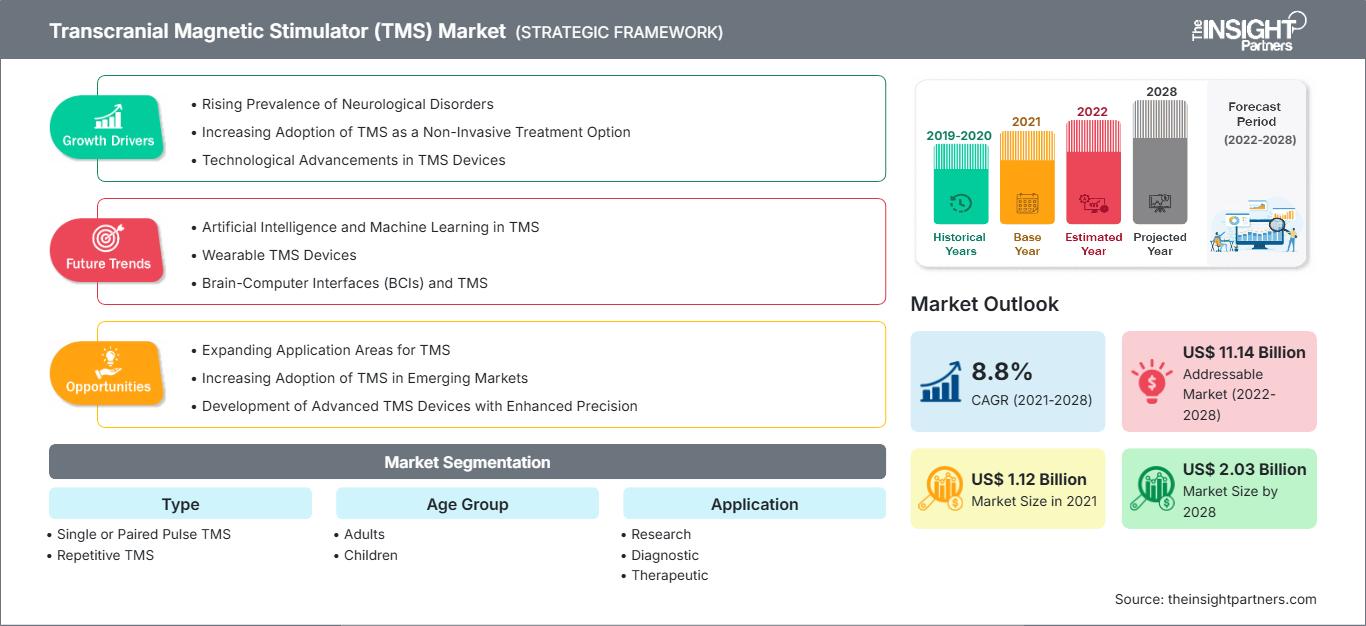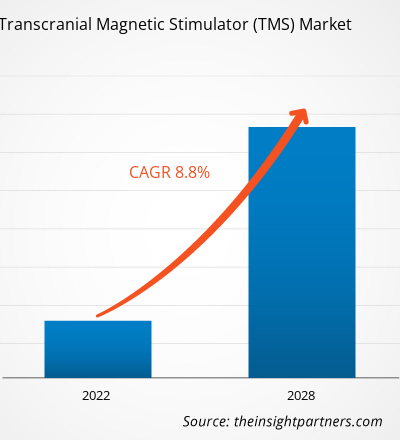[研究报告]经颅磁刺激器 (TMS) 市场规模预计将从 2021 年的 11.2222 亿美元增至 2028 年的 20.2971 亿美元;预计 2021 年至 2028 年的复合年增长率为 8.8%。
神经系统疾病会影响人体的大脑和神经,并导致癫痫和癫痫发作、帕金森病、痴呆症、自闭症、阿尔茨海默病、脑肿瘤和脑瘫等。神经系统疾病的患病率在全球范围内呈上升趋势。根据2017年全球疾病负担研究(GBD)的数据,就伤残调整生命年(DALY)总量而言,阿尔茨海默病和其他痴呆症[255万DALY]、中风[约358万DALY]和偏头痛(约240万DALY)是美国三大最沉重的神经系统疾病。
此外,阿尔茨海默病协会估计,超过600万美国人患有阿尔茨海默病,预计到2050年这一数字将达到近1300万。经颅磁刺激器(TMS)广泛用于神经系统疾病的诊断和治疗。例如,根据BrainsWay Ltd.的数据,2021年4月,全球有10万名患者接受了其深部TMS治疗。因此,神经系统疾病的日益流行推动了全球经颅磁刺激器 (TMS) 市场的增长。此外,抑郁症是全球常见的精神疾病之一。根据世界卫生组织 2020 年 1 月发布的数据,全球各年龄段共有超过 2.64 亿人患有抑郁症。
自定义此报告以满足您的要求
您将免费获得任何报告的定制,包括本报告的部分内容,或国家级分析、Excel 数据包,以及为初创企业和大学提供超值优惠和折扣
经颅磁刺激器(TMS)市场: 战略洞察

- 获取本报告的主要市场趋势。这个免费样本将包括数据分析,从市场趋势到估计和预测。
市场洞察
经颅磁刺激 (TMS) 是一种非侵入性治疗手段,有助于治疗神经系统疾病。此外,TMS 技术的不断发展也扩大了其应用范围。经颅磁刺激器 (TMS) 市场的公司正在采取各种策略,例如争取其创新产品的美国食品药品监督管理局 (FDA) 批准、建立业务合作伙伴关系以及筹集产品开发资金,这些策略推动了市场的增长。 您将免费获得任何报告的定制,包括本报告的部分内容,或国家级分析、Excel 数据包,以及为初创企业和大学提供超值优惠和折扣
经颅磁刺激器(TMS)市场: 战略洞察

- 获取本报告的主要市场趋势。这个免费样本将包括数据分析,从市场趋势到估计和预测。
以下是一些进展示例:
- 2021 年 3 月,MagVenture 推出了 MagVenture Flow Arm——一款正在申请专利的临床定位系统——旨在优化 MagVenture 已获 FDA 批准的非侵入性脑刺激技术方案的实施,该技术可用于治疗重度抑郁症和作为强迫症 (OCD) 的辅助疗法。
- 2020 年 8 月,MagVenture TMS 疗法获得 FDA 批准,可用于辅助治疗强迫症 (OCD)。这是丹麦医疗器械公司 MagVenture 在美国获得的第二项适应症。
- 2019 年 2 月,私营医疗技术公司 eNeura, Inc. 宣布获得 FDA 新的 510(k) 许可。该公司声称,凭借此项批准,sTMS 是美国唯一一款用于治疗成人和儿童(12 岁及以上)急性和预防性偏头痛的偏头痛产品。
因此,全球参与者积极参与经颅磁刺激及相关技术的开发,预计将支持市场增长。
基于类型的洞察
根据类型,经颅磁刺激器 (TMS) 市场细分为单脉冲或双脉冲 TMS 和重复 TMS (rTMS)。2021 年,单脉冲或双脉冲 TMS 细分市场占据了更大的市场份额。然而,预计重复 TMS (rTMS) 细分市场在 2021 年至 2028 年期间的复合年增长率将更高。基于应用的洞察
根据应用,市场细分为研究、诊断和治疗。 2021 年,诊断领域占据了最大的市场份额,预计未来几年将以最高的复合年增长率增长。在经颅磁刺激器 (TMS) 市场运营的公司强调采用产品创新战略来满足全球不断变化的客户需求,这也使他们能够在全球市场上保持自己的品牌名称。经颅磁刺激器(TMS)市场
The Insight Partners 的分析师已详尽阐述了预测期内影响经颅磁刺激器 (TMS) 市场的区域趋势和因素。本节还讨论了北美、欧洲、亚太地区、中东和非洲以及南美和中美洲的经颅磁刺激器 (TMS) 市场细分和地域分布。
经颅磁刺激器(TMS)市场报告范围
| 报告属性 | 细节 |
|---|---|
| 市场规模 2021 | US$ 1.12 Billion |
| 市场规模 2028 | US$ 2.03 Billion |
| 全球复合年增长率 (2021 - 2028) | 8.8% |
| 历史数据 | 2019-2020 |
| 预测期 | 2022-2028 |
| 涵盖的领域 |
By 类型
|
| 覆盖地区和国家 | 北美
|
| 市场领导者和主要公司简介 |
|
经颅磁刺激器 (TMS) 市场参与者密度:了解其对业务动态的影响
经颅磁刺激器 (TMS) 市场正在快速增长,这得益于终端用户需求的不断增长,而这些需求的驱动因素包括消费者偏好的演变、技术进步以及对产品优势的认知度不断提升。随着需求的增长,企业正在扩展产品线,不断创新以满足消费者需求,并抓住新兴趋势,从而进一步推动市场增长。

- 获取 经颅磁刺激器(TMS)市场 主要参与者概述
- 单脉冲或双脉冲 TMS
- 重复 TMS (rTMS)
按年龄组
- 成人
- 儿童
按应用
- 研究
- 诊断
- 治疗
按地域
- 北美
- 美国
- 加拿大
- 墨西哥
- 欧洲
- 法国
- 德国
- 意大利
- 英国
- 西班牙
- 欧洲其他地区
- 亚太地区 (APAC)
- 中国
- 印度
- 南韩国
- 日本
- 澳大利亚
- 亚太地区其他地区
- 中东和非洲 (MEA)
- 南非
- 沙特阿拉伯
- 阿联酋
- MEA 其他地区
- 南美洲和中美洲 (SCAM)
- 巴西
- 阿根廷
- SCAM 其他地区
公司简介
- BrainsWay Ltd
- Nexstim, Magstim
- Neuronetics
- TMS Neuro Solutions
- MagVenture, Inc.
- eNeura Inc.
- Neurosoft
- MAG & More GmbH
- 历史分析(2 年)、基准年、预测(7 年)及复合年增长率
- PEST和SWOT分析
- 市场规模、价值/数量 - 全球、区域、国家
- 行业和竞争格局
- Excel 数据集
近期报告
客户评价
购买理由
- 明智的决策
- 了解市场动态
- 竞争分析
- 客户洞察
- 市场预测
- 风险规避
- 战略规划
- 投资论证
- 识别新兴市场
- 优化营销策略
- 提升运营效率
- 顺应监管趋势




















 获取免费样品 - 经颅磁刺激器(TMS)市场
获取免费样品 - 经颅磁刺激器(TMS)市场